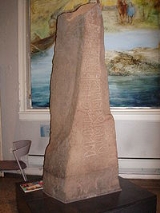
Tune stone
Encyclopedia
The Tune stone is an important runestone from about 200-450 CE. It bears runes of the Elder Futhark
, and the language is Proto-Norse. It was discovered in 1627 in the church yard wall of the church in Tune
, Østfold
, Norway
. Today it is housed in the Norwegian Museum of Cultural History in Oslo
. The Tune stone is possibly the oldest Norwegian attestation of burial rites
and inheritance
.
The A side reads:
The B side reads:
The transcription of the runic text is:
The English translation is:
The name Wiwaz means "darter" while Woduridaz means "fury-rider." The phrase witandahlaiban that is translated as "my lord" means "ward-bread" or "guardian of the bread." (The English word "lord" similarly originated from an Old English phrase meaning "guardian of the bread".)
in 1903 and Carl Marstrander
in 1930, but the full text was not interpreted convincingly until 1981 by Ottar Grønvik
in his book Runene på Tunesteinen.
Elder Futhark
The Elder Futhark is the oldest form of the runic alphabet, used by Germanic tribes for Northwest Germanic and Migration period Germanic dialects of the 2nd to 8th centuries for inscriptions on artifacts such as jewellery, amulets, tools, weapons and runestones...
, and the language is Proto-Norse. It was discovered in 1627 in the church yard wall of the church in Tune
Tune, Norway
Tune is a former municipality in Østfold county, Norway. The former municipality originally covered the current Sarpsborg municipality with the exception of Skjeberg and with the addition of Rolvsøy.-History:...
, Østfold
Østfold
is a county in southeastern Norway, bordering Akershus and southwestern Sweden , while Buskerud and Vestfold is on the other side of the bay. The seat of the county administration is Sarpsborg, and Fredrikstad is the largest city.Many manufacturing facilities are situated here. Moss and...
, Norway
Norway
Norway , officially the Kingdom of Norway, is a Nordic unitary constitutional monarchy whose territory comprises the western portion of the Scandinavian Peninsula, Jan Mayen, and the Arctic archipelago of Svalbard and Bouvet Island. Norway has a total area of and a population of about 4.9 million...
. Today it is housed in the Norwegian Museum of Cultural History in Oslo
Oslo
Oslo is a municipality, as well as the capital and most populous city in Norway. As a municipality , it was established on 1 January 1838. Founded around 1048 by King Harald III of Norway, the city was largely destroyed by fire in 1624. The city was moved under the reign of Denmark–Norway's King...
. The Tune stone is possibly the oldest Norwegian attestation of burial rites
Funeral
A funeral is a ceremony for celebrating, sanctifying, or remembering the life of a person who has died. Funerary customs comprise the complex of beliefs and practices used by a culture to remember the dead, from interment itself, to various monuments, prayers, and rituals undertaken in their honor...
and inheritance
Inheritance
Inheritance is the practice of passing on property, titles, debts, rights and obligations upon the death of an individual. It has long played an important role in human societies...
.
Inscription
The stone has inscriptions on two sides, called side A and side B. Side A consists of an inscription of two lines (A1 and A2), and side B consists of an inscription of three lines (B1, B2 and B3), each line done in boustrophedon style.The A side reads:
-
- A1: ekwiwazafter`woduri
- A2: dewitadahalaiban:worathto`?[---
The B side reads:
-
- B1: ????zwoduride:staina:
- B2: þrijozdohtrizdalidun
- B3: arbijasijostezarbijano
The transcription of the runic text is:
-
- A: Ek Wiwaz after Woduride witandahlaiban worhto r[unoz].
- B: [Me]z(?) Woduride staina þrijoz dohtriz dalidun(?) arbija arjostez(?) arbijano.
The English translation is:
-
- I, Wiwaz, made the runes after Woduridaz, my lord. For me, Woduridaz, three daughters, the most distinguished of the heirs, prepared the stone.
The name Wiwaz means "darter" while Woduridaz means "fury-rider." The phrase witandahlaiban that is translated as "my lord" means "ward-bread" or "guardian of the bread." (The English word "lord" similarly originated from an Old English phrase meaning "guardian of the bread".)
Interpretations
The runic inscription was first interpreted by Sophus BuggeSophus Bugge
Sophus Bugge was a noted Norwegian philologist and linguist. His scientific work was directed to the study of runic inscriptions and Norse philology. Bugge is best known for his theories and his work on the runic alphabet and the Poetic Edda and Prose Edda. -Background:Elseus Sophus Bugge was...
in 1903 and Carl Marstrander
Carl Marstrander
Carl Johan Sverdrup Marstrander was a Norwegian linguist, known for his work on the Irish language. His works, largely written in Norwegian, on the Celtic and Norse components in Norwegian culture, are considered important for modern Norway.-Life:...
in 1930, but the full text was not interpreted convincingly until 1981 by Ottar Grønvik
Ottar Grønvik
Ottar Nicolai Grønvik was a Norwegian philologist and runology scholar.He was a lecturer from 1959 and associate professor from 1965 to 1986, at the University of Oslo. His doctorate thesis which earned him the dr.philos. degre in 1981 was Runene på Tunesteinen...
in his book Runene på Tunesteinen.

